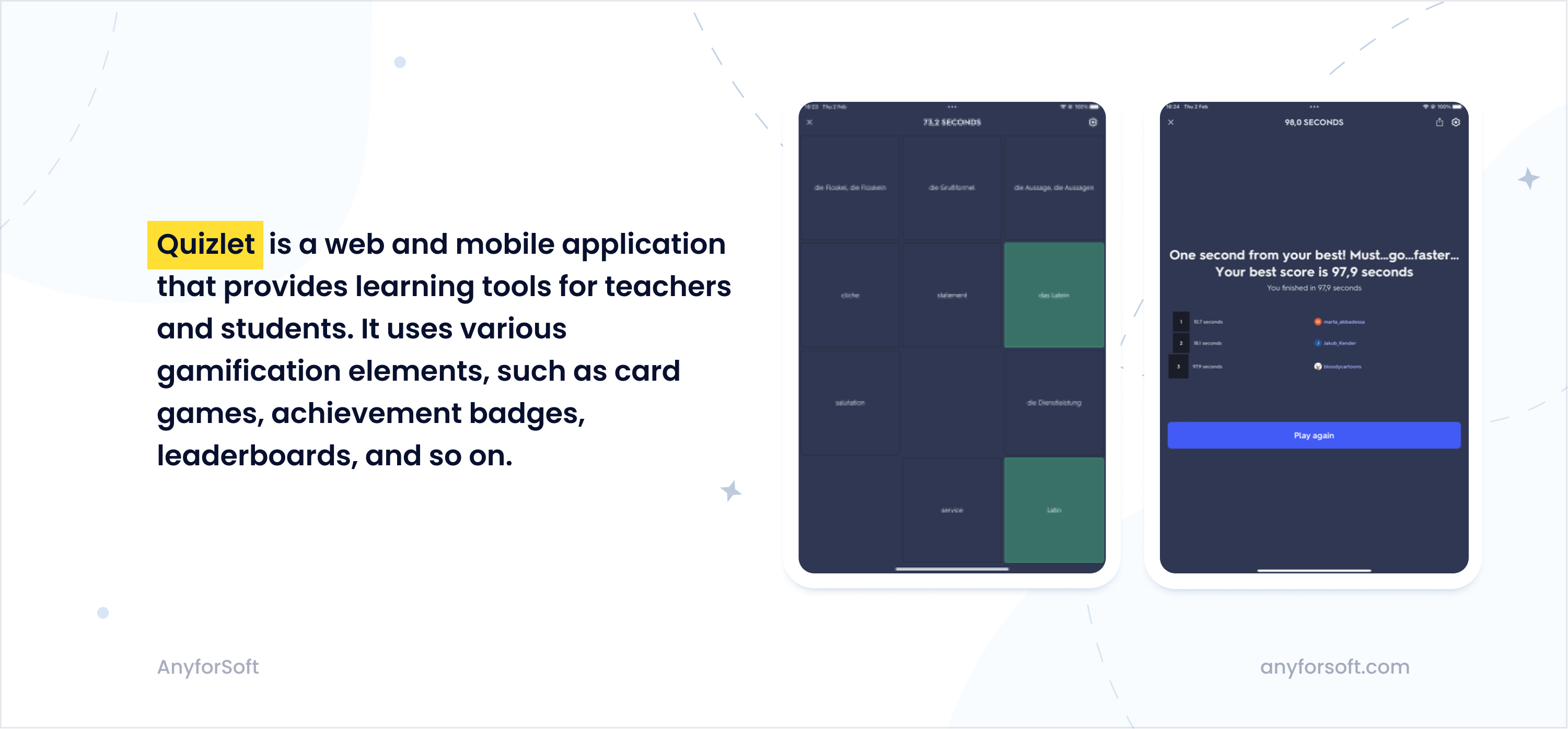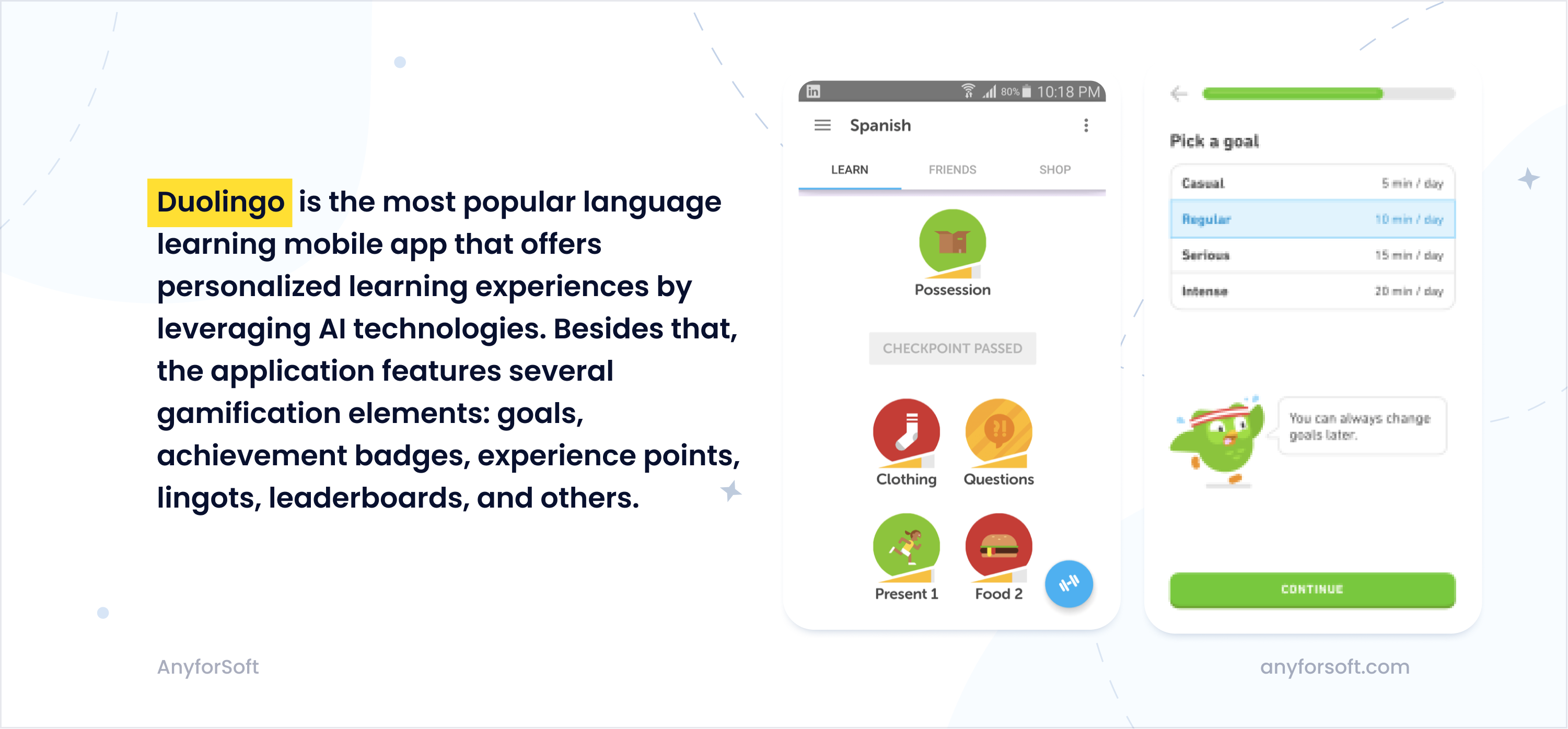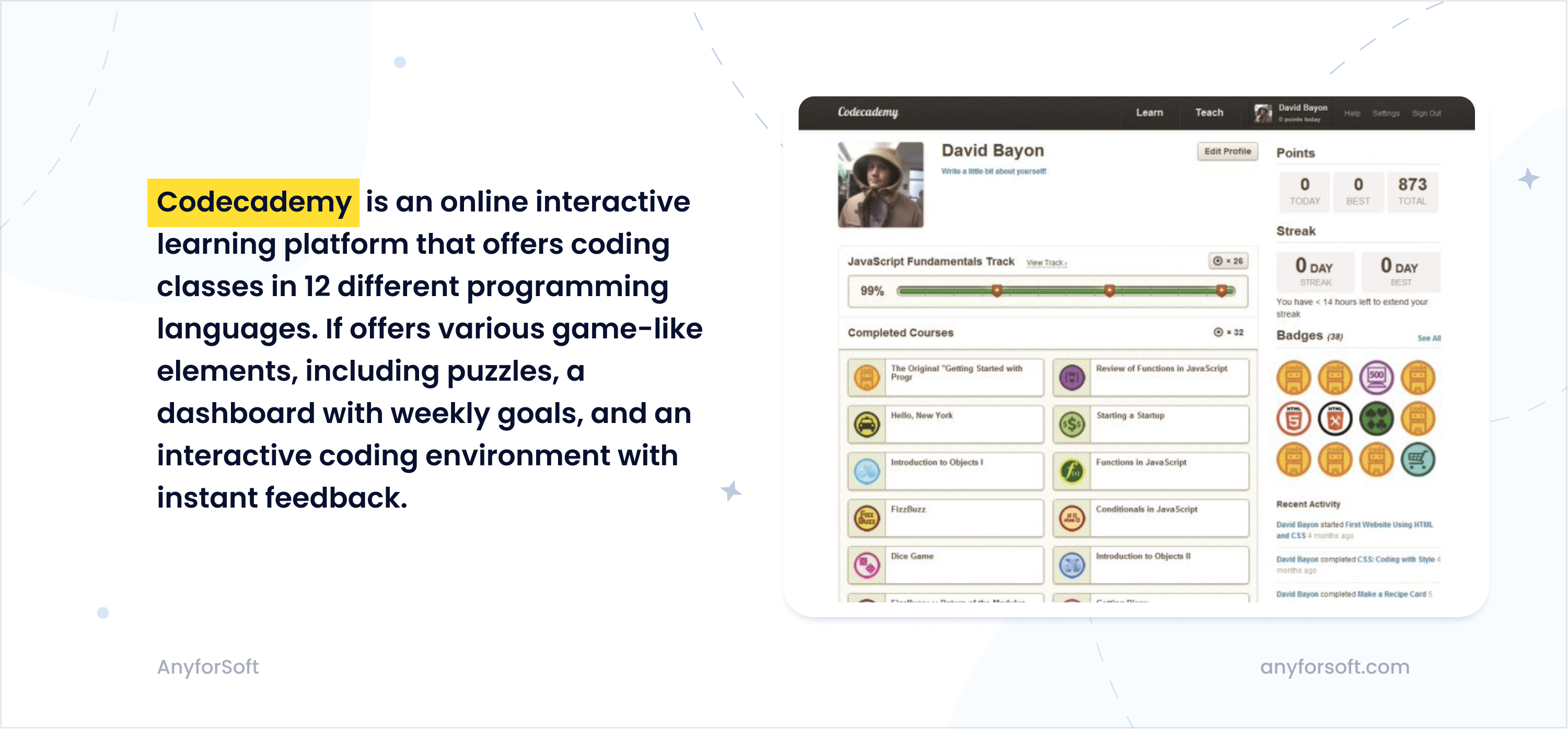Sometimes it is hard to engage users, especially when it comes to learning. The process of learning something is often associated with boredom, dullness, and repetitiveness. To acquire new knowledge or skill, a learner has to be strongly disciplined, patient, and perseverant; and let’s be honest, many lack these qualities.
But what if we turn the learning process into something engaging and fun? What if we make it feel like a game?
That is what gamification in e-Learning is all about. By introducing game elements to your educational app, you will make the learning experience more interactive and exciting while significantly enhancing user retention.
As a company that specializes in e-Learning software development, AnyforSoft wants to elaborate more on the importance of gamification in the e-Learning industry. Keep reading to:
- learn what gamification in e-Learning is;
- see examples of applications that use gamified elements;
- explore the benefits of gamification;
- discover best gamification practices, and more.
Without further ado, let’s get started.
What is gamification in e-Learning?
In simple terms, gamification in online learning is adding game-like elements and gaming mechanics to online learning platforms. These game-based elements include:
- Achievement badges. Achievement badges are virtual rewards that learners receive for completing specific tasks, milestones, or achievements within your learning system. These gaming elements serve as a visual representation of the learner’s progress, motivating them to finish their online course.
- Leadership boards. Introducing leaderboards is a perfect way to gamify e-learning and enhance the learning experience. Leaderboards are game elements that display the rankings of learners based on different metrics (points earned, levels completed, quiz scores, etc.). They introduce healthy competition to your platform, motivating learners to study harder in order to outperform their fellows.
- Points. Points are effective game mechanics that increase student engagement and improve the learning experience. Points are awarded to learners for completing activities, answering questions correctly, or achieving specific goals within the e-learning platform. They offer immediate feedback on performance, helping learners analyze their mistakes and improve.
- Progress indicators. Progress indicators are interactive elements that display the learner’s progress through training programs, courses, and modules. They give the users a sense of achievement, encouraging them to keep going and finish what they’ve started.
- Mini-games. The term “mini-games” is self-explanatory. These interactive activities offer learners a break from traditional e-learning programs while still reinforcing learning objectives. In the “Examples Of Gamification In E-Learning” part, we explain this in more detail.
- Quizzes. Quizzes are assessments presented in the form of questions or exercises that test learners' understanding of the course material. This gamified e-learning element helps learners better memorize the material by applying their knowledge. Quizzes also provide feedback on comprehension and identify areas for further improvement.
The primary goal behind eLearning gamification is to make the learning journey more interactive, appealing, and engaging, thus increasing user retention rates.
Gamification of e-Learning has nothing to do with creating an entire video game alongside your online courses. As noted above, it is about introducing game mechanics to your application to turn rather boring learning activities into fun and engaging experiences.
For example, by creating leadership boards, you will introduce healthy competition to your e-Learning course. That will motivate learners to study harder in order to outperform their fellows. You can also add awarding badges to provide learners with a sense of achievement and incentivize hard work.
To better learn how to use gamification in e-Learning apps, let’s investigate some real-life examples.
Examples of gamification in e-Learning
These gamification examples will help you understand how to implement game-like mechanics in your own application.
#1 Multiple gamification elements in Quizlet

We already mentioned this app in our article on education app design—make sure to check it out if you haven’t already. So Quizlet is a web and mobile application that provides learning tools for teachers and students, such as classes, study sets, quizzes, textbooks, and flashcards. For instance, teachers can create flashcards with scientific terms and their explanations for students to learn.
However, instead of just flipping through the flashcards and memorizing them, learners can play a game. More specifically, they can match term cards with explanation cards against the clock. Upon the end of the game, the app shows a leaderboard with the students that matched the cards the fastest. That adds a competitive spirit to the app and encourages learners to repeat the game until they receive a higher position on the leaderboard. And the more they play, the better they learn the material. That way, the learning process becomes fun and entertaining rather than boring and repetitive.
Apart from the above, Quizlet utilizes:
- Instant feedback. Upon completion of each study set, a student receives instant feedback on how well they performed. The app shows their test score and indicates mistakes (if any). That helps in identifying areas of improvement.
- Achievement badges. Quizlet offers a wide variety of badges. For example, a user can receive an achievement badge for using the application for 3 days in a row. Or they can obtain it for finishing a specific number of study sets.
- Personalized online learning experience. Quizlet enables learners to choose their own way and pace of learning content. They can learn study sets by playing a matching game (the one described above), memorizing flashcards, or through customized tests.
#2 Killer gamification features of Duolingo

With over 300 million users worldwide, Duolingo is arguably the most popular language learning mobile app. It offers personalized learning strategies by leveraging AI technologies. The application is great at forming a habit of language learning, with its bite-size learning, gamified learning elements, fun challenges, and reminders from their friendly mascot, Duo the owl, which has become a famous internet meme.
Let’s look at some e-Learning gamification techniques the app puts to use.
- Awarding badges. Duolingo uses lots of awarding badges to provide learners with a sense of achievement. For example, you can get one for using the app for three days in a row.
- Experience points. Upon the completion of a lesson or a story, each user is rewarded with experience points (XP). These points are displayed on user profiles and indicate their language level. Learners with the most experience points are featured in Duolingo leagues and leaderboards, which introduces healthy competition to the app.
- Lingots. Lingots are Duolingo’s own in-app currency that can be earned by meeting daily learning goals, leveling up, unlocking achievements, and through other activities. This currency can be spent on new lessons, various power-ups, cute outfits for Duo the owl, and more.
#3 Learning coding through gamification with Codecademy

Another great example of gamification in e-Learning is Codecademy.
As you probably know, learning how to code is no easy feat. It is a monotonous, tedious, and complicated process that requires perseverance and patience. However, the gamification of e-Learning activities can turn even such a complicated task as acquiring coding skills into a fun and interactive experience.
Thanks to the gamification strategies of Codecademy, everyone can learn coding in a more entertaining way.
Codecademy is an online interactive learning platform that offers coding classes in 12 different programming languages including Java, JavaScript, Python, Ruby, and others.
Let’s look at how Codecademy is gamifying e-Learning, adding gamification practices to its learning content:
- Puzzle games. Codecademy uses puzzle games as a way to simplify the learning of programming languages and improve knowledge retention. By breaking down complex programming concepts into smaller, bite-sized puzzles, the platform allows learners to grasp these concepts more easily.
- Dashboard with weekly goals. The platform also offers a dashboard where you can set your weekly learning goals and monitor your progress. For example, you can set a goal to study 5 days a week, and Codecademy will help you track how well you are performing in that regard. That will help you improve learning habits.
- Interactive coding environment with instant feedback. The coding environment on Codecademy is divided into three sections: the theory section, where you can read how to apply coding principles, the code editor section, where you add and edit code, and the result section, which shows results of your work in real time. Given that you receive instant feedback after every action, you can quickly hone your skills and minimize mistakes.
Benefits of gamification in e-Learning
Now that we’ve seen some examples of gamification in e-Learning, it’s time we discussed its benefits. So what does gamification add to e-Learning in terms of advantages? Let’s see.
Better learning outcomes
Recent research indicates that game-based learning is more effective than traditional learning. More specifically, those who study with gamification elements perform better on tests than those studying in a more conservative manner. Thus, with a thought-out gamification strategy, you can achieve great progress in corporate training or reach other learning objectives.
Increased user retention
Gamified e-Learning is engaging and fun, and thus it retains users better than traditional learning tools. With gamification, learning apps can even win the attention of those who don’t like studying at all, which is a significant advantage. So gamify your eLearning course and you will engage learners much more effectively.
Higher completion rates
A gamified course has a higher chance of being fully completed. Thanks to leadershipboards, progress indicators, and various other features, apps that use gamification for eLearning give users an idea of how far they’ve come in their learning path. That’s critical because when a learner sees what progress they’ve already achieved, this motivates them to keep going. Thus, they’re less likely to abandon their education. No wonder gamification is so heavily used in employee training.
Easier learning
In the example of Codecadamy, we’ve seen how even complex subjects such as coding can be made easier with gamified e-Learning. By introducing game-like features and gamified assessments to your educational app, you will make the learning process less intimidating and more fun. This will help you broaden and diversify your audience, resulting in higher income.

How to Use Gamification in E-learning: Best Practices
Now that you’ve learned what game-based learning is and seen prominent examples of gamification in e-learning, let’s talk about how to apply the gamification approach in your learning environment. There are several rules you should follow to succeed:
Rule #1: Don’t add gamification just for the sake of it. Don’t introduce gamification elements because your competitors are doing it. Add them to improve the learning experience and actually help learners achieve progress. That said, your gamification strategy should be perfectly aligned with the learning objectives, with every element contributing to the learning outcomes.
Rule #2: Be transparent on criteria and progression. Your learners should know how gamified content works in order to stay engaged and motivated. Make sure that your educational games are well-explained: users should know for what they get their points, how these points translate into achievement badges, what criteria they should meet to receive a new award/unlock a new level, and so on. If the rules aren’t clear, don’t expect learners to play along.
Rule #3: Increase the difficulty gradually. People love challenges, but if you make game-based learning too difficult right from the start, you will discourage them. That’s why we recommend increasing the difficulty gradually. Start with something easy—let your learners collect some awards and achievement badges without much effort. Once they get a taste for it, make the game more challenging to keep them interested and engaged.
Rule #4: Allow social interaction. Why achieve something when you can’t share it with others, right? Every major e-learning platform understands the need of learners to share their achievements so they incorporate social interaction functionality. We advise you to do the same. Enable learners to share their achievements on social media—not only will this motivate them to study harder, but it will also help you promote your platform for free.
Rule #5: Ensure personalization. Personalization of learning and gamification is critical for your platform’s success. Obviously, each learner is different, and if you manage to tailor the learning experience for every user’s learning needs, you will help them study more effectively. So make sure to use adaptive difficulty levels, personalized learning paths, customized feedback based on learner performance, and other personalization strategies.
Rule #6: Facilitate continuous learning. Find ways to encourage learners to keep returning and improving their scores. You can do that by regularly resetting leaderboards, introducing new challenges or rewards, using push notifications, and so on. Give learners a reason to keep coming back for more rather than considering their learning “done.” If you do that right, your audience engagement and retention will increase dramatically.
Rule #7: Keep accessibility and inclusivity in mind. When designing gamified e-learning courses, don’t forget about accessibility and inclusivity. You should take into account diverse learning styles, disabilities, and cultural backgrounds to ensure that all learners have equal opportunities to participate and succeed. That way, you will enhance the learner experience and will be able to target a wider audience, which will eventually translate into more income for your business.
Rule #8: Provide immediate feedback. Gamification in corporate training and other learning activities should always come with some form of feedback. Therefore, you should always offer immediate and constructive feedback to learners as they engage with educational content. This feedback loop can come in various forms, such as points, badges, or visual cues, and should help learners understand, their progress, learning processes, and areas for improvement.
Rule #9: Include visual aids. Gamification in the educational context should leverage appealing design and aesthetic elements to draw learners into participating in the game. One of the easiest ways to make learning fun is by adding visual aids. This includes visual hooks, typographic elements, user-friendly navigation, visual pointers, and so on. By introducing these elements, you will make your platform more visually appealing while making sure no one gets lost when exploring it.
Conclusion
When it comes to e-Learning, gamification is a great tool that can do wonders. By using gamification in your software, you can educate much more effectively, increase user retention and engagement rates, encourage learners to complete your courses, achieve great progress in corporate training, and, of course, make learning more enjoyable.
So why hesitate? If you aim to provide better learning experiences, you should definitely contribute to the gamification industry and add gamification to your tool.
AnyforSoft could help you with a task like this. Having over 12 years of experience, we have managed to benefit various educational organizations all over the world. That gives us deep industry knowledge that we can implement to help your company prosper.
Contact us today, and let’s discuss your project!
